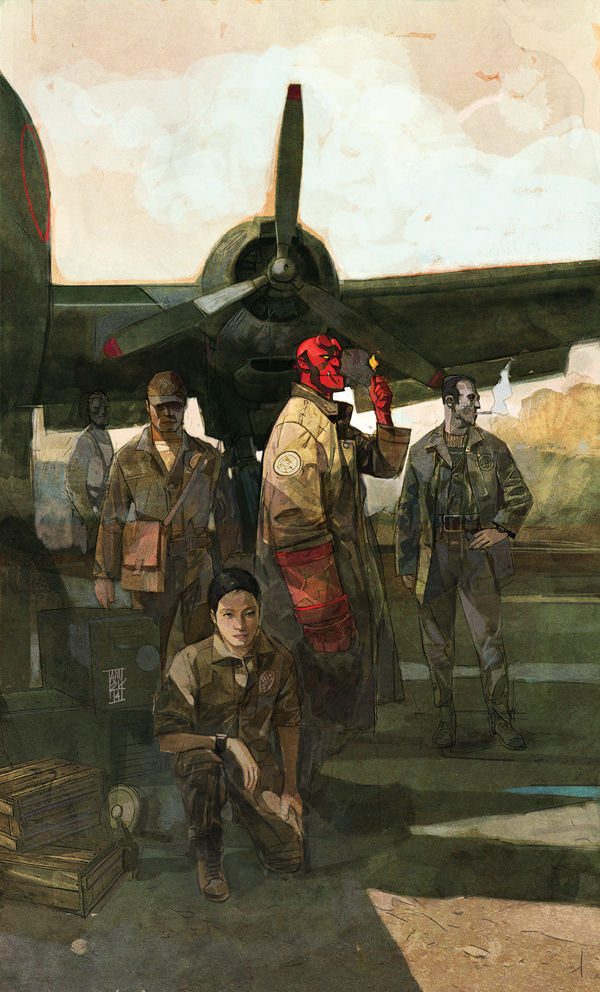
By Matthew Jent
Hellboy and the BPRD #1
Writers: Mike Mignola & John Arcudi
Artist: Alex Maleev
Colorist: Dave Stewart
Cover Artist: Alex Maleev
Genre: Horror, Fantasy, Action/Adventure
Publisher: Dark Horse Comics
“You’re taking Hellboy with you.”
In the mid-1990s I was in high school and looking for rebellion. Something to get pretentious about. It was a search for some kind of pre-hipster deep knowledge. Oh, you like superhero comics? Meh. I’m more of a Vertigo fan.
Then I found the comic book rebellion I was looking for. A group of comics creators, writers and artists of some renown, banded together and abandoned the Big Two publishers in order to make creator-owned work, following their passion and making the comics they wanted to make, unrestricted by corporate mandates, editorial oversight, and comics code authorities.
No, not the one you might be thinking of. I’m talking about Dark Horse’s Legend imprint. Founded by John Byrne and Frank Miller, it encompassed their extant Next Men and Sin City books, Paul Chadwick’s Concrete, and new series from creators like Art Adams, Geoff Darrow, and others. I was fifteen and looking for a bandwagon to jump on. So I decided Legend was going to be that bandwagon. Every creator, every book, the complete imprint: I was going to read them all.
Which leads us to Hellboy: Seed of Destruction. Growing up with superheroes, I wasn’t a big Mike Mignola fan. I knew him from covers and annuals and the occasional mini-series, and his art had always been too blocky, too weird, to squiggly for my tastes. But Hellboy, whatever that meant, was a Legend book, and more than that, it was tied in, however lightly, to the “Torch of Liberty” backup that was going to run with Byrne’s Danger Unlimited miniseries, so I was willing to buy it, skim it, and board it.
That was 20 years ago. If you’re reading this Hellboy review and wondering what a Torch of Liberty or a Danger Unlimited is, or even — yikes! — whatever happened to Concrete, that’s partly a testament to Mike Mignola and Hellboy, one of the few enduring comic book creations of the modern era. Inspired by mythology, pulp fiction, weird horror, and action-adventure stories, Hellboy was the book Mignola was made for, and it’s been published pretty continuously ever since that first issue of Seed of Destruction. There have been toys, cartoons, and a couple major motion pictures, but there’s never been a reboot or a relaunch. The universe has expanded to include solo series or one-shots for Abe Sapien, Lobster Johnson, and the whole Bureau for Paranormal Research and Defense. They’re not always written and drawn by Mignola anymore, but hey — the guy created a world around the idea that the (possible) Anti-Christ is a superhero/paranormal investigator. That’s fertile ground for a shared universe.
This December sees the release of Hellboy and the BPRD. In the year that Hellboy turns 20 for real, this series flashes back to 1952 to tell the tale of Hellboy’s first mission with the Bureau. This issue — like most Hellboy comics — is dripping with dread and foreboding. Professor Bruttenholm, the Director of the BPRD and Hellboy’s Earthly father figure, sends a team of soldiers and investigators to Brazil to look into a series of murders supposedly committed by a “superhuman creature,” the descriptions of which vary. They have a small plane, a contact in a Brazilian village, and orders to bring along the untested Hellboy, who is otherwise sitting on his bed, tossing playing cards, chilling with a pet dog. There are some visions of the future and worries (spoken and unspoken) as to whether Hellboy will be a force for good or evil, but any longtime fan of the character knows that the red guy has a heart o’ gold.
The art from Alex Maleev and Dave Stewart is a great fit for Mignola & Arcudi’s story, and for the world of Hellboy. The shadows are dark (though not as oppressive as in Mignola’s own art), and the architecture is appropriately doom-laden. There are very few examples of characters free-floating in space — when that does happen, there’s always evidence elsewhere on the page of where these characters are. Objects, walls, backgrounds — ceilings! — painting a full picture of the space these characters inhabit. It might seem like a small thing, but with very little action in the first issue, Maleev and Stewart do a great job of establishing tone and tension through their use of setting and space.
As for the story? There’s always a push and pull to serialized storytelling. Do you write for the trade? For the periodical? Do you just tell the story you want to tell, and let page counts fall where they will? Hellboy and the BPRD #1 falls into the same category as a lot of modern first issues, meaning there’s a lot of setup without any denouement. That setup is thorough, and the tension and weirdness grows with an appropriate balance of pacing and characterization — two of the four BPRD agents are interchangeable, but Archie and Xiang are interesting enough to allow for a few potential redshirts on the team — but there’s no release of that tension. It’s an issue-long intake of breath, with no exhale. If you consider this as a single issue in a 20-years-and-growing tale, that’s not a bad thing. But as the first issue of a new series, I was looking for one more 4-6 page scene or cutaway that gave a clearer sense of what this story would be about. The first issue of a Hellboy series doesn’t need to provide a clear shot of the villain or an assessment of the threat at hand, but when I get to page 22 of any comic and I find myself genuinely wondering if the ending has been cut off (and this was a review copy, so it’s possible), I consider that a storytelling misstep.
Single issues like this are hard to review out of context. The short version is, If everything comes together, this is a very good beginning. The longer version is, well, everything else you’ve read to this point.
That said, I don’t need a more complicated pitch to continue reading than “Mike Mignola tells the story of Hellboy’s first field assignment.” Hellboy and the BPRD is building on a 20-year bank of weird horror, existential dread, and tales well told. This isn’t a great jumping-on point for new readers, but it’s a promising start to an untold tale in a decades-long serialized story.
Hellboy and the BPRD #1 will be released on December 3rd, 2014.
I noticed a common feature in the comics I was reading this week, a feature that made them all compelling as stories: the role of the underdog pitted against overwhelming odds. Seeing the psychological reactions of the characters was an important part of the ride, but excellent artwork, particularly in executing fight scenes, left me more than impressed with each one. HELHEIM #1 (out March 6th), TRIGGER GIRL 6 (out March 13th), and SLEDGE-HAMMER 44 (out March 13th) strike a fluid balance between characterization and action, always a kind of brass ring for comics creation, though sometimes a little difficult for readers to come by.
[Spoilers for HELHEIM #1, TRIGGER GIRL #6, and SLEDGE-HAMMER 44 #1 below]

[HELHEIM #1]
HELHEIM, from Oni Press, kicks off a new series, and so has a great deal of storytelling to accomplish in a single issue. It does this with axes, axes, and more axes. Though it’s true there are plenty of axes, there’s also a lot more to HELHEIM, a tale “of the North” featuring what I’ll assume from the title are Vikings. Joelle Jones (FABLES) illustrates the issue, and her style is not only eye-catching but moody. Her characters in profile resemble figures from Viking-age artifacts but also have an angularity to their movement that really establishes the world of HELHEIM. I mentioned fight-scenes. These are equally unique and captivating. Though pseudo-medieval fight scenes are common enough in comics to keep you from really paying attention to the detail of their rendering, Jones breaks down that familiarity through unique panel layouts, occasionally rounded to depict landscape or full-page with overlaid panels to create emphasis. If she impresses with her Vikings, she’s even more at home with her artwork conjuring the undead, which sets up the forthcoming themes of the series well. There’s a kind of epic weight to some of her panels that simply stays with you, a sign of excellent art.
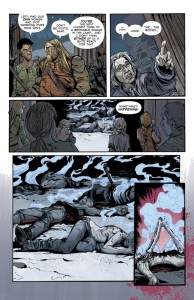
[HELHEIM #1]
Writer Cullen Bunn keeps up the pace of the story with driving action, and combines many of the tropes from medieval sagas without slowing things down. He establishes the role of kin relationships straight off the bat as central hero Rikard tries to save his wounded son, but ultimately has to leave the corpse behind, and then engages with both his father and other relatives at their timber fort under siege. Family relationships make for good drama, particularly in 580 AD. This forms a large part of the psychology of Rikard in his role as protector, but also as father and son. But it’s the supernatural elements Bunn includes that I particularly applaud, from Rikard seeing a vision of his own bleeding ghost predicting his imminent death (this happens in Irish Sagas of the period, and perhaps Viking too), to the rising corpses of his recently slain grotesque foes pursuing him. These are some of the elements that make Viking sagas great in their own right, including blue-faced undead who haunt houses and pound on the roof, calling the cowering inhabitants by name. Bunn brings the most evocative moments of Viking tales to new life, but isn’t afraid to introduce his own developments, like the series premise set up in #1, that Rikard can be resurrected by witchcraft to act as a vengeful Franken-Viking. If the rest of the series shows such careful consideration as this issue, the combination of powerful artwork and strong storytelling will be well worth the read.
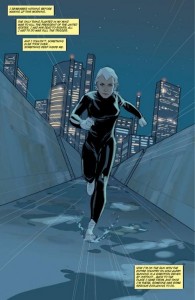
[TRIGGER GIRL 6]
TRIGGER GIRL 6, the compilation volume of the series that appeared in the too soon cancelled magazine CREATOR OWNED HEROES, but thankfully presented as a whole by Image, already took fans by storm in 2012, but seeing the series in one unit was entirely worth the wait. Phil Noto’s artwork on the series is simply dazzling, from sleek line-work to color themes. Noto has the uncanny ability to present moments of stillness in the midst of action that creates a sense of vertigo for the reader. Since about two thirds of the story-line involves clone Trigger Girl 6’s attempt to assassinate the president of the USA, hang on tight. The plot calls for handling animals in a majestic, impressive role and Noto proves up to the challenge, too, making you wonder if there’s anything that’s not his forte when it comes to comic art. The pastel hues of the early stages of the story also merge into ethereal jungle settings within any jarring sense of transition. From near-future technology to talking animals, Noto knows the score.

[TRIGGER GIRL 6]
Jimmy Palmiotti and Justin Gray bring us a story in TRIGGER GIRL 6 that defies you to doubt its central truths. In an included interview, the collected volume expresses Palmiotti and Gray’s concern about big corporations, and the increasingly “overpopulation and greed” in modern society that gives weight to the whole TRIGGER GIRL concept. It’s not just a beautifully drawn assassin story (though that would probably be enough to sell the book), but it’s also a commentary on social conscience. The character of Trigger Girl 6 also develops and expands for the reader, drawing us into her psychology. While TG 6 is silent and therefore mysterious in the early stages of the story, after her escape from government interrogation, Palmiotti and Gray also include inner monologue text boxes that emphasize her own internal questions and search for identity. Though this is often a common feature of sci-fi clone stories, it’s always compelling when it’s handled well, and Palmiotti and Gray manage to convey a great deal about her personality in such a brief story arc. What’s most impressive about the story, though, is that the writers bring out their big themes in what’s effectively a single-issue finale as TG 6 discovers the biological haven where she was born and the scientifically enabled talking animals who have created her. It’s a wild idea, but it doesn’t feel forced in the least, and engages with a long history of social commentary and sci-fi literature that reflects on human behavior and finds it lacking. To say the story has heart would be an understatement; it has compassion and concern. The fact that Palmiotti and Gray feel that they can reach comics readers with such a weighty message elevates the medium in all the right ways.

[SLEDGE-HAMMER 44]
SLEDGE-HAMMER 44 #1, from Dark Horse, introduces a character from Mike Mignola and John Arcudi who has his own mysterious origins and motivations. Like a lot of intriguing Dark Horse comics set in the HELLBOY universe, WWII and the Nazi legacy feature, but this story focuses on the role of fighting men and establishes a skillful balance between the fantastic and the historically grounded. Jason Latour’s artwork has a lot to do with the success of this balance. His blend of stylized linework with military detail suggests 1940’s comic art dealing with war, and the fairly unusual (from Dark Horse) sepia and muted tones of Dave Stewart’s color palette set the comic apart as something a little different. It hints that the war, and its own epic aspects, are as important as the heroic figure that the comic introduces: Sledge-Hammer. But for steam-punk and technology fans, there’s also plenty to love in Latour’s artwork. Mike Mignola’s cover art set up the design of Sledge-Hammer’s mechanoid appearance in his characteristic wood-block imprint style, but Latour also brings a sense of the human to Sledgehammer’s anatomy and appearance, from the first panel where he’s introduced, looming large in his army jacket, to his explosive one-man operation fight scenes where he takes a beating from a Nazi robot. The comic has got atmosphere in spades thanks to the artistic team work involved.
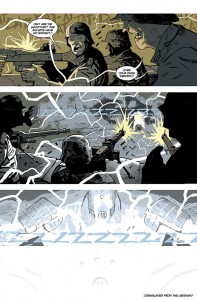
[SLEDGE-HAMMER 44]
Mignola and Arcudi also craft a story with universal appeal through grounding the reader in the perspective of soldiers watching the mysterious Sledge-Hammer operation in action, as well as through giving Sledge-Hammer a speaking role even this early in the story-line. He may be a being of few words, but urging the soldiers to leave him behind and save themselves sets Sledge-Hammer up as a classic heroic being, capable of miscalculation (he seems not to have seen the Nazi robot coming), but also of personal sacrifice. It’s also a wise move that Mignola and Arcudi don’t give too much away about Sledge-Hammer’s mentality, leaving the reader to make assumptions and hang on for the next installment to learn more about whether this metal soldier has any other human characteristics, and what exactly motivates his driven actions against the Nazis. It’s a comic staged for a grand entrance of a unique character, and all the better for picking out the details of wartime experience in Europe through secondary characters. Like many projects that Mignola works on, the storytelling feels decompressed to allow the images to tell their own tale, often with only a few panels per page. The comic calls for more dialogue, actually, than many of Mignola’s works, to create a sense of experiencing conflict on the ground during WWII. The story feels particularly unencumbered by having to fit into any specific moment in a wider mythology, and for that reason it has an overpowering sense of being something new, brisk, and somewhat unpredictable. If you read issue #1, it’ll be almost impossible not to follow SLEDGE-HAMMER into its second issue whether due to its lavish homage artwork or its fresh storytelling, but most likely a combination thereof.
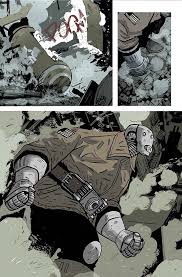
[SLEDGE-HAMMER 44]
These three comics display a strikingly high standard for comic artwork, really setting their artists loose to develop an aesthetic appropriate to the worlds they’re creating. It helps that the reader is following central characters into conflict and watching them battle it out against the odds within their own stories. This gives action scenes even more of an edge and also leads the reader deeper into the psychological layers of the storytelling involved. All three comics celebrate the role of the hero, taking traditional elements and redefining them according to the personal vision of their respective creative teams. HELHEIM #1, TRIGGER GIRL 6, and SLEDGE-HAMMER 44 #1 prove that you don’t have to choose between spectacular art or strong storytelling in comics: you can actually find them both in one package if you’re lucky.
Title: HELHEIM #1/Publisher: Oni Press/Creative Team: Cullen Bunn, Writer, Joelle Jones, Illustration, Nick Filardi, Colors, Ed Brisson, Letters
Title: TRIGGER GIRL 6/Publisher: Image Comics/Creative Team: Jimmy Palimiotti, Justin Gray, Writers, Phil Noto, Artwork, Bill Tortolini, Letters, Design
Title: SLEDGE HAMMER 44 #1/Publisher: Dark Horse Comics/ Creative Team: Mike Mignola, John Arcudi, Writers, Jason Latour, Artwork, Dave Stewart, Colors, Clem Robins, Letters
Hannah Means-Shannon writes and blogs about comics for TRIP CITY and Sequart.org and is currently working on books about Neil Gaiman and Alan Moore for Sequart. She is @hannahmenzies on Twitter and hannahmenziesblog on WordPress.
 I grew up reading Cracked and Mad magazines, hunting in various grocery newsstands for old and new issues and then checking my Velcro wallet for the cash and change to afford my habit. Even if I didn’t understand all of the jokes, I returned again and again for the film parodies--and much of this was due to artist John Severin, who passed away at age 90 last week.
I grew up reading Cracked and Mad magazines, hunting in various grocery newsstands for old and new issues and then checking my Velcro wallet for the cash and change to afford my habit. Even if I didn’t understand all of the jokes, I returned again and again for the film parodies--and much of this was due to artist John Severin, who passed away at age 90 last week.
Among his many illustrative talents, Severin excelled at capturing the likenesses of celebrities while adding his flair for caricature. Even when he played it straight, Severin’s characters expressed a herky-jerky sense of movement that suggested a smirk on behalf of the artist behind the pencil. He had ink in just about every mainstream comics publisher--from EC to DC, Marvel to Dark Horse, among others--and he continued to perfect and express his art until his passing; his latest work published only last month in Witchfinder: Lost and Gone Forever, a project written by Mike Mignola and John Arcudi. It’s worth repeating that he was 90 years old and still producing professional artwork.
Last weekend, I re-read Lost and Gone Forever--very much a serious horror tale--and marveled at Severin’s ability to blend a Wild West setting with the supernatural. Mignola and Arcudi’s scripts call for Severin to bring to life Native American mythology and Victorian sensibilities, Buffalo-headed heroes and zombie hordes--and Severin excels. The dream sequences reveal themselves as legitimate surprises. Severin masks these scenes as part of the normal narrative until it’s too late for the reader to turn back and realize he or she has been duped. Severin’s work may be a bit sketchier than it was during his Cracked years (a 45-year relationship), but it’s still very much on par with his contemporaries. Much like my first read of Lost and Gone Forever, I could not stop partway through. I read it in one sitting because I had to--Severin, Mignola, and Arcudi? It’s a collaboration that dares the reader to blink, and I do not envy the artist who has to follow with the next Witchfinder installment.
For more on John Severin’s career (he had the awesome middle name of “Powers,” by the way), please see the AV Club, The Beat, and the farewell at The Comics Journal (which also features a hefty interview with the artist). Thank you, Mr. Severin. I wore out my wallet’s Velcro-adhesive with justifiable admiration.
--Alex












